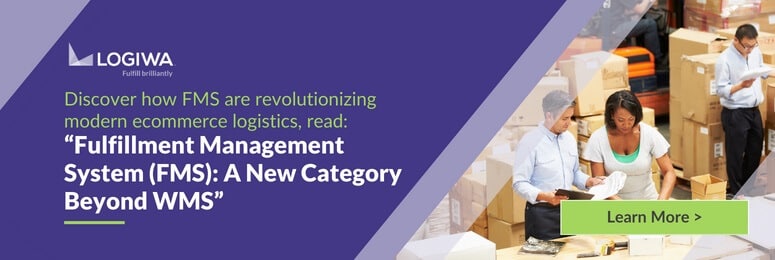5 Ways to Make Your Retail Distribution Management Strategy Work For You
Distribution management refers to the efficient and successful movement of goods from the point of production to the point of sale. It’s a catch-all term that encompasses a wide range of activities, including:
- Inventory management
- Warehouse management
- Supplier and vendor relationship management
- Logistics management, and more
Retailers thrive when they quickly produce and sell products. The longer they hold goods, the higher the chances of spoilage, theft, damage, or obsolescence. Inventory may be the lifeblood of your business, but it can also be its curse when managed poorly.
An excellent distribution management strategy generates value across the supply chain. By monitoring your distribution efforts, you gather actionable data about how well your products move from the manufacturing plant to the warehouse and, finally, to the customer. When you identify bottlenecks and inefficient processes, you can address them and shave days and dollars off your supply chain.
Why is Distribution Management Important?
At a basic level, effective distribution management helps your business grow. For instance, if you didn’t have at least a network of distribution centers or warehouses, you’d have to store all of your inventory at your small retail branch. You would struggle to properly manage those goods and it would be difficult to quickly respond to stockouts — you would have to go directly to the manufacturer instead of simply ordering more product from your warehouse.
Once you have a distribution network, a distribution management strategy helps you effectively leverage it. Consider these potential inefficiencies:
- You don’t have a sophisticated inventory management system (IMS). Consequently, you have multiple data points instead of a single source of truth, limiting your ability to answer customer questions or set accurate reorder points.
- You don’t have an advanced warehouse management system (WMS). Consequently, your warehouse workers take much longer than necessary to putaway, pick, and pack orders.
- You have not optimized your warehouse layout. Consequently, your warehouse’s instances of motion waste increase significantly, delaying customer deliveries and increasing labor costs.
- You do not have a transportation management system (TMS). Consequently, you can’t access real-time information about carrier rates or choose the most optimal trucking route to lower shipping costs without delaying customer deliveries.
- Your TMS and WMS are not integrated. Consequently, your inbound and outbound logistic schedule and your warehouse picking waves are not aligned. Packages that need to be delivered by 5:00 P.M. are not on the last truck of the day because your warehouse staff spent the first half of the day picking goods that don’t have to be delivered until next week.
- You have not negotiated your shipping rates. Even though you ship a high volume of goods at a high frequency, you have not leveraged your bargaining power to secure value-adds or volume discounts from your carriers.
A distribution management strategy evaluates your supply chain in its entirety and identifies areas for cost savings and value creation. Plus, it helps inform your marketing efforts. With a distribution network that keeps costs low, you can promote your products competitively while still earning a profit.
The Anatomy of a Distribution Network
Every company’s distribution network will look a little different, but fundamentally they all consist of:
- Retailers / stores
- Warehouses / distribution centers (DCs)
- Manufacturing plants
- Carriers / transportation providers
Some retailers own some or all of their distribution network. This means that their company operates its own warehouses or has a fleet of trucks dedicated to its business.

Other companies rent warehouse space, use private package delivery services like UPS to deliver their goods, or outsource some or all of their distribution network to a third-party logistics provider (3PL).
In both cases, companies (or their 3PLs) are aiming for the same distribution management goals:
- Successfully fulfill customer orders: This means delivering the right goods to the right customers at the right time.
- Consistently deliver customer value: This means giving your customers what they need, and that means something different for every company. Your supply chain should align with what your customers value. For instance, if your primary customers are food and beverage companies, then your supply chain will need to excel at just-in-time (JIT) delivery.
- Quickly adapt to market changes: This means building a supply chain that can quickly respond to changes in the market, like a disruptive new technology or a new product from competitors.
- Rapidly respond to potential disruptions: This means understanding risks and creating contingency plans for all the things that could go wrong with your supply chain. This encompasses a large number of things, including natural disasters, cyber attacks, and labor disruptions.
- Boost the bottom line: This means going beyond cost savings and finding ways to generate value by increasing sales or entering new markets through innovative distribution strategies.
Let’s take a look at each of these in more detail and discuss how to create specific, measurable, and time-bound strategies for these different objectives.
1. Strategies for Successfully Filling Customer Orders
Successfully filling customer orders is your supply chain’s most obvious goal.
Poor fulfillment has a serious impact on customer retention. Customers spend time choosing the product they want online–they expand the web image, carefully select a color, indicate the right size, and more. Then, they anticipate the product’s arrival. It’s quite a buzz kill when they receive the wrong product.
It may be an honest mistake, but it dilutes the shopping experience. While eCommerce allows consumers to shop in their pajamas, the experience still falls short in one big way: instant gratification. E-retailers have addressed this by accommodating shorter and shorter shipping times. But, same-day delivery doesn’t do a thing if your customer receives the wrong item.
The first step in developing an effective strategy is to define your objective. So, how do you set a precise order fulfillment goal?
First, you need to choose which on-time delivery metrics you want to measure:
- Number of units ordered
- Date of delivery
- Number of line items per order
Once you’ve chosen your metrics, you need to define your metrics since they can mean different things to different business owners.
For instance, if you deliver 9 out of 10 units of an item to your customer, and they agree to receive the remaining unit another day, will you still consider this an on-time delivery?
Once you’ve defined your metrics — and received buy-in from your stakeholders about their definitions – you should take a look at the data for a previous time period. This will help you create a goal like:
We will achieve an on-time delivery accuracy rate of 98% by the end of Q2 in 2020. To be considered an on-time delivery, the delivery must include the correct quantity and style of units.
2. Strategies for Consistently Delivering Customer Value
Understanding your customers plays a big role in keeping them over the long term. It’s also a good way to reduce customer crises and expensive re-adjustments to your supply chain operations.
As a retailer, understanding your customer means understanding how you can generate value for the customer.
One way to do it is by delivering an omni-channel retail experience. Your customers don’t just shop in store. They shop through native mobile apps, social media channels, and your online store. Even if you have the front-end tools to provide these experiences, you need the right distribution management practices on the back end to properly deliver on them.
Designing the right distribution management strategy for an omni-channel retail experience requires two parts: a technology enhancement and an operational adjustment.
On the technical side, you will need to purchase a sophisticated inventory management software (IMS). Your new IMS should connect to your in-store point-of-sale system and your eCommerce channels, including your browser-based site and your mobile app. Essentially, there will be multiple purchase points, but there will only be one bucket of inventory, ensuring both you and your customers have access to accurate numbers.
On the operational side, you will need to change how you fulfill orders. Once you’ve integrated your new IMS, you’ll have a single source of truth enabling you to fulfill orders from any physical source of stock.
If a customer orders a bag that’s available at both your retail store and your warehouse, but your retail store is closer to the customer’s address, you can ship from your store. The integrated system updates the inventory records across the board.
In one real-world example, Brooks Brothers took this approach when they restructured their supply chain to ship suits and shirts from any of its 260 North American stores.
Your goal for adding value to customers may be:
By the end of Q1 2020, we will have chosen an inventory management system vendor. By the end of Q2 2020, we will have implemented our chosen inventory management system and successfully adapted our order fulfillment operations to make our retail stores play a bigger role in our distribution network.
Better Warehouse Performance = Higher Profit Margins: Logiwa syncs accurate data across your entire interface so the inventory numbers you see on your dashboard are what your employees see on their devices. Learn how Logiwa uses real-time data to help you get up to 100% inventory accuracy and 2.5x shipments.
3. Strategies for Quickly Adapting to Market Changes
The market is always changing. Companies that respond quickly survive while those who ignore the signs or grow complacent falter.
As a retailer, your supply chain is vulnerable to all kinds of changes, including:
- Globalization
- Increasing consumer expectations
- New market entrants
- Rising offshore labor costs
One survey of mid-market C-level executives found that a quarter of respondents who relocated for cost-saving purposes didn’t achieve the level of savings they’d anticipated.
So, how can you build an adaptive supply chain?
- Create an adaptive operating model where different functions can be scaled down or up based on the market
- Develop a variable cost structure to give your organization wiggle room
- Standardize processes and systems to make it easy to expand or shut down services, if needed
Your goal for this may be:
By end of Q4 2019, identify supply chain functions that could represent unsustainably high costs in a market downturn. By Q1 2020, present standard operating procedures and models for rapidly scaling those functions’ costs down by 20 to 40 percent, if ever needed.
4. Strategies for Rapidly Responding To Potential Disruptions
Much like creating a resilient supply chain, this is one of those goals that you can’t measure until things take a turn for the worst. But, you know what they say: Fail to prepare, prepare to fail. The best thing you can do for these scenarios is create risk mitigation plans.
As a retailer, you rely on your supply chain to stay in business. As a result, you need a business continuity plan as part of your distribution management efforts. A business continuity plan identifies critical business functions, communicates where backups are located, who the main points of contact are during an emergency, and how things will operate during the emergency.
Creating a business continuity plan – and then regularly running through it and updating it – helps your organization avoid the confusion and panic that comes after a cyberattack or a natural disaster.
In this instance, your distribution management goal could be:
Identify critical areas of the business and write a detailed business continuity plan with designated points of contact by the end of Q1 2020.
5. Strategies for Boosting the Bottom Line
Your supply chain can achieve greater objectives than keeping costs low (although keeping costs low is important).
An innovative distribution management plan empowers you to offer greater value to customers and increase your conversion rates. Consider the Amazon Prime program and its free two-day shipping for members. This offer is only possible because of Amazon’s phenomenal distribution management strategy, and it generates results.
According to one report, the conversion rate for Amazon Prime members is 74% while the conversion rate for non-Prime members drops all the way to 13%. Talk about giving your customers what they want and reaping the rewards!
With an excellent distribution chain, you can also beat your retail competitors. For instance, Zara’s innovative supply chain allows them to get the latest fashion to customers and beat fast fashion competitors.
An innovative supply chain has the potential to revolutionize your business and even introduce new revenue streams.
Your distribution goal in this respect may be to:
Generate $X in additional revenue through innovative distribution management strategies by the end of Q4 2020.
Understanding Your Distribution Management Strategy is Worth The Effort
A well-managed distribution management strategy saves retailers time and money. It provides a framework for retailers to evaluate their distribution networks and supply chains, and helps them discover opportunities for efficiency and value generation. By ensuring the successful and cost-effective movement of your goods from the manufacturing point to the sales point, you can protect and grow your business.
The Leading Supply Chain Management Software for “New Age” B2C/B2B Fulfillment Businesses
3PL
Cloud 3PL software for high-volume fulfillment excellence






